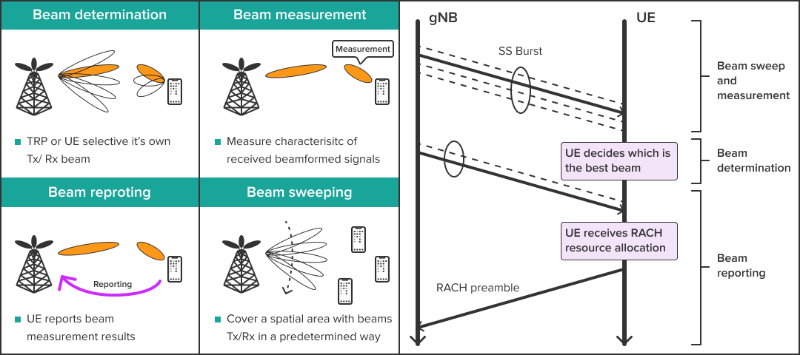Beamforming and Massive MIMO are key technologies that enhance spectrum efficiency and boost capacity and coverage. This blog explores the adoption of these technologies in 5G, likewise the benefits and challenges of their deployment.
Beamforming and mMIMO
Beamforming is a technique that enables steering a large antenna array dynamically to shape the direction of multiple main and null beams by adjusting the phase and amplitude of the radio signals. Unlike traditional antennas, which only send and receive fixed radiation patterns, beamforming-enabled antennas transmit and receive radio signals in a specific direction by targeting connected users’ locations.
Conversely, Multiple-Input Multiple-Output (MIMO) antennas have been in use for many years in commercial wireless systems to boost capacity, including Wi-Fi and the latest advancements of LTE networks. Since 5G requires supporting more dynamic scenarios than in legacy networks, MIMO leverages beamforming to further enhance both coverage and capacity of the mobile system. MIMO uses beamforming to focus signals on each user as it allows the base station to control the antennas transmitting the signal. By concentrating these signals in a specific direction, beamforming reduces interference for the devices that are not in the target area.
In comparison with LTE, 5G NR supports massive MIMO that can utilize an even larger number of antenna elements. It contains at least 16T16R antenna elements and transceivers. Nonetheless, the commercial mMIMO solutions can include 32 or 64 transceivers. The 2D antenna arrays are capable of 3D beamforming in both the azimuth and elevation plane.
|
TxRx |
Antenna
(Row * Column * Polarization) |
Tx/Rx |
| 64T64R | 128 (8*8*2) | 64 |
| 32T32R | 64 (8*4*2) | 32 |
| 16T16R | 96 (12*4*2) | 16 |
Increased capacity and improved user experience
Beamforming antennas are unique in improving the signal-to-interference-and-noise ratio (SINR), meaning that users receive strong signals, and consequently, a better experience. Moreover, beamforming assists in enhancing the network supply in rural areas. The deployment of beamforming at radio sites helps expand the network coverage in the rural areas, thus increases data throughput for more people outside of the big cities.
Beamforming is a crucial enabler for operators to deliver the high-speed, low latency, and high-reliability network demanded by 5G. This is because it helps Millimeter-wave frequencies (higher frequency bands in the sub-6 GHz spectrum) support user mobility via reflection and steering signals to end devices.
3GPP Beam Management Procedures
The 5G NR specifications comprise new initial access procedures to ensure alignment of the directional transmissions. In 3GPP terminology, these are called beam management procedures which include the following operations:
- Beam sweeping: The radiating pattern covers a spatial area with a set of beams transmitted and received according to pre-specified intervals and directions.
- Beam measurement: It corresponds to the quality of the received signal evaluation at the gNodeB or the User Equipment (UE). The UE measures the beams, maintaining a set of candidate beams coming from multiple cells. The metrics measured are signal power (SS-RSRP), quality (SS-RSRQ), and signal-to-interference-plus-noise ratio (SS-SINR) for each beam.
- Beam determination: It corresponds to the suitable beams selection, either at the gNB or the UE, based on the results in beam measurement.
- Beam reporting: The UE sends the beam quality and decision information to the Radio Access Network (RAN) and establishes the communication link.

The 5G coverage is beam-based rather than cell-based. In 5G, each cell has one or multiple Synchronization Signal Block Beam (SSB) pointing in the same direction and forming a grid that covers the cell area. Physical Cell ID (PCI) and beam ID are used to identify the beams from each other. Then, SSB beams show up as a new layer of mini-cells inside each cell in the field measurements.
Deployment Challenges
Massive MIMO and beamforming introduce significant benefits but also pose challenges for radio operators. Operators need to validate and optimize the beam management procedure’s impact on the connection set-up time and the Quality of Service (QoS) in those connections to prevent dropped calls or poor performance. Furthermore, they need to validate the active antenna channel performance and the achieved throughput for successful beam steering implementation in 5G.
Context-aware QoE service and application delivery are essential in 5G design. This technology demands much more rigorous UE-based testing than legacy networks to verify and optimize the initial access and beam management.
Additional challenges are presented when using Millimeter-wave (mmWave) because high-band frequencies are susceptible to propagation loss from environmental conditions. Maintaining the communication link quality is a difficult task, especially when end-users are on the move.
To make all these validations, the operators require counting with decoded mobility beam management information. This can be very complex because most of them have different vendor-specific implementations, which will likely impact data collection and measurement processing.
CovMo Solution
CovMo geolocation platform collects and processes massive RF, call, and data session information generated by Multi-vendor radio networks. This allows for a clear view of the beam management procedures to better execute beam-centric radio monitoring. Likewise, CovMo can help plan and optimize the MIMO performance to ensure that Operators’ 5G networks deliver enhanced customer experience.
CovMo supports call trace flow chart, permitting advanced call analysis with complete detail of every L3 event. The user can drill-down to individual beam level (Beam-ID) information to quickly identify poor RF performance root cause and troubleshoot it.
CovMo exclusive features, such as subscriber and UE-oriented data arrangement, allow for deep insights into individual device performance. This is critical to ensure the UE can perform beam tracking and switching.
To learn more about CovMo, contact us at https://www.ghtinc.com/alliance-request/.

